Estimation of the Actual Specific Consumption in Drinking Water Supply Systems in Burkina Faso (West Africa): Potential Implications for Infrastructure Sizing
Abstract
1. Introduction
2. Materials and Methods
2.1. Study Area Description
2.2. Study Data and Analysis
2.2.1. Data Preparation
2.2.2. Selection of Explanatory Variables
- The centre size: population is one of the main determinants of water demand for drinking water. When sizing SDWSS networks, a common and simple method of estimating future demand is to multiply the total population by the specific consumption. In our sample, the population size of the centres varies between 2465 and 16,965 inhabitants, with a mean of 7153 and a standard deviation of 3369 inhabitants. To relate, the national standard [12,13] defines a minimum threshold of 3000 inhabitants for a centre to benefit from an SDWSS. We define three (03) modalities according to the size of the population for a given centre, i.e., “unsuitable” (population < 4627 inhabitants), “suitable” (4627 < population < 9090 inhabitants) and “highly suitable” (population > 9090 inhabitants). The thresholds of 4627 and 9090 inhabitants are, respectively, the first (Q1) and third (Q3) quartiles of the population size distribution in our sample of SDWSS centres.
- The centre status: which is either semi-urban or rural. The drinking water demand is generally higher in semi-urban areas but relatively low in rural areas [47]. In this study, the sample of 40 SDWSS includes 36 “semi-urban” centres and 4 “rural” centres.
- The abundance of alternative water sources: this includes alternative water points, such as boreholes and permanent or temporary wells existing in the locality. The number of such alternative water sources is translated into a coverage ratio (Tr_aws), calculated as in Equation (1):where N_sawp is the number of working Stand-Alone Water Points (SAWP) in the centre, Pop is the population size in the centre, and 300 refers to the population supplied through a given SAWP, as defined in [12,13]. We defined three modalities for Tr_aws: “scarce” (Tr_aws < 0.7, i.e., 10 centres), “abundant” (0.7 ≤ Tr_aws < 1.0, i.e., 10 centres) and “very abundant” (Tr_aws ≥ 1.0, i.e., 20 centres). The Tr_aws factor has a direct influence on water consumption in rural and semi-urban areas since it has been observed that after the implementation of an SDWSS, the population rarely change their water use pattern and continues to rely on alternative sources, often for washing or dishwashing purposes [48].Tr_aws = (N_sawp × 300)/Pop
- The geological nature of the subsoil: either sedimentary or basement. From a geological point of view, a sedimentary area is more favourable for wells and boreholes than a basement area. Centres located in a basement area sometimes struggle to have positive wells [46]. Moreover, the wells realised in such contexts often run dry during the dry season. In such cases, the population has no choice but to rely on SDWSS. In the study sample, 25 centres were located in the sedimentary area and 15 centres in the basement area.
- The seasonality of the centre: in centres with a high level of agricultural activity, water consumption is typically influenced by the season, as a strong migratory movement of the population towards crop hamlets is often observed at the onset of the rainy season. This behaviour is, however, less pronounced in centres where agricultural activities are limited or barely existent [50]. In our sample, nine centres are classified as “seasonal sites”.
- The energy supply source: either electric, thermal or mixed. The energy source used to power the system defined the cost required per cubic meter pumped within the SDWSS and, therefore, the water pricing [51,52,53]. In our study sample, 18 centres are supplied by the electric power grid, 20 centres through a power generator, and 2 are mixed power supplied centres.
2.2.3. Analysis Methods
3. Results and Discussion
3.1. Comparative Analysis of Actual and Standard Daily Average Specific Consumption
3.2. Multiple Correspondence Analysis (MCA)
3.2.1. Variable and Individual Factor Maps
3.2.2. Cluster Analysis
3.3. Determinants of Specific Daily Consumption
3.4. Decision Tree for Estimation of Suitable Specific Daily Consumption
3.5. Future Areas of Research
4. Conclusions
Author Contributions
Funding
Data Availability Statement
Acknowledgments
Conflicts of Interest
References
- Mays, L.W.; Koutsoyiannis, D.; Angelakis, A.N. A brief history of urban water supply in antiquity. Water Supply 2007, 7, 1–12. [Google Scholar] [CrossRef]
- Sambu, D. Impact of global initiatives on drinking water access in Africa. Afr. Geogr. Rev. 2016, 35, 151–167. [Google Scholar] [CrossRef]
- Lèye, B.; Zouré, C.O.; Yonaba, R.; Karambiri, H. Water Resources in the Sahel and Adaptation of Agriculture to Climate Change: Burkina Faso. In Climate Change and Water Resources in Africa; Diop, S., Scheren, P., Niang, A., Eds.; Springer International Publishing: Cham, Switzerland, 2021; pp. 309–331. ISBN 978-3-030-61224-5. [Google Scholar]
- Agarwal, A.; de los Angeles, M.S.; Bhatia, R.; Chéret, I.; Davila-Poblete, S.; Falkenmark, M.; Villarreal, F.G.; Jønch-Clausen, T.; Kadi, M.A.; Kindler, J.; et al. Integrated Water Resources Management; TAC Background Papers, No. 4; Global Water Partnership/Swedish International Development Agency: Stockholm, Sweden, 2000. [Google Scholar]
- Biswas, A.K. Integrated Water Resources Management: Is It Working? Int. J. Water Resour. Dev. 2008, 24, 5–22. [Google Scholar] [CrossRef]
- UNWWAP. The United Nations World Water Development Report: Water for A Sustainable World; World Water Assessment Programme; UNESCO: Paris, France, 2015; Volume 1, ISBN 978-92-3-100071-3. [Google Scholar]
- Diakité, D.; Thomas, A. La demande domestique d’eau potable: Une étude sur un panel de communes ivoiriennes (Domestic demand for drinking water: A study of a panel of Ivorian communes). Actual Écon. 2012, 87, 269–299. [Google Scholar] [CrossRef]
- Dos Santos, S. L’accès à l’eau en Afrique subsaharienne: La mesure est-elle cohérente avec le risque sanitaire? (Access to water in sub-Saharan Africa: Is the measure consistent with the health risk?). Environ. Risques Santé 2012, 11, 282–286. [Google Scholar] [CrossRef]
- Sajjadi, S.A.; Alipour, V.; Matlabi, M.; Biglari, H. Consumer Perception and Preference of Drinking Water Sources. Electron. Physician 2016, 8, 3228–3233. [Google Scholar] [CrossRef] [PubMed]
- WHO; UNICEF (Eds.) Global Water Supply and Sanitation Assessment 2000 Report; World Health Organization: Geneva, Switzerland; UNICEF: New York, NY, USA, 2000; ISBN 978-92-4-156202-7. [Google Scholar]
- Dos Santos, S. Accès à l’eau et enjeux socio-sanitaires à Ouagadougou—Burkina Faso (Access to water and social and health issues in Ouagadougou—Burkina Faso). Espace Popul. Soc. 2006, 2–3, 271–285. [Google Scholar] [CrossRef]
- MEA. Programme National d’Approvisionnement en Eau PoTable 2016–2030 (National Drinking Water Supply Programme 2016–2030); Ministère de l’Eau et de l’Assainissement—Burkina Faso (MEA): Ouagadougou, Burkina Faso, 2016. [Google Scholar]
- MEA. Document Cadre de Gestion du Service Public de l’eau Potable en Milieu Rural au Burkina Faso (Framework Document for the Management for Public Drinking Water Service in Rural Areas in Burkina Faso); Ministère de l’Eau et de l’Assainissement—Burkina Faso (MEA): Ouagadougou, Burkina Faso, 2019. [Google Scholar]
- Howard, G.; Bartram, J. Domestic Water Quantity, Service Level and Health 2003, WHO/SDE/WSH/03.02. Available online: https://apps.who.int/iris/handle/10665/67884 (accessed on 1 July 2023).
- Labhasetwar, P.K.; Yadav, A. Membrane Based Point-of-Use Drinking Water Treatment Systems; IWA Publishing: London, UK, 2023; ISBN 978-1-78906-272-4. [Google Scholar]
- Prost, A. L’eau et la santé (Water and health). In Populations et Environnement Dans les Pays du Sud; Economie et Développement; Karthala: Paris, France; CEPED: Paris, France, 1996; pp. 231–251. ISBN 2-86537-670-2. [Google Scholar]
- Gleick, P.H. Basic Water Requirements for Human Activities: Meeting Basic Needs. Water Int. 1996, 21, 83–92. [Google Scholar] [CrossRef]
- DGEP. Inventaire National des Ouvrages Hydrauliques (National Inventory for Hydraulic Infrastructures); DGEP: New Delhi, India, 2017. [Google Scholar]
- Valiron, F. Mémento du Gestionnaire de L’alimentation en Eau et de L’assainissement; Tec et doc-Lavoisier: Paris, France; New York, NY, USA, 1994; ISBN 978-2-85206-935-0. [Google Scholar]
- Point, P. Partage de la ressource en eau et demande d’alimentation en eau potable (Sharing water resources and demand for drinking water supply). Rev. Écon. 1993, 44, 849. [Google Scholar] [CrossRef]
- Mbaye, N.M. Analyse de la Demande en eau Dans les Centres Secondaires et les Centres Ruraux au Burkina Faso (Analysis of Water Demand in Secondary and Rural Centres in Burkina Faso). Master’s Thesis, International Institute for Water and Environmental Engineering (2iE), Ouagadougou, Burkina Faso, 1998. [Google Scholar]
- Sanoussi, I.A. Analyse de la Demande en eau Dans les Petits Centres Urbains au Burkina Faso (Analysis of Water Demand in Small Urban Centres in Burkina Faso). Master’s Thesis, International Institute for Water and Environmental Engineering (2iE), Ouagadougou, Burkina Faso, 1997. [Google Scholar]
- Jaglin, S. The right to water versus cost recovery: Participation, urban water supply and the poor in sub-Saharan Africa. Environ. Urban. 2002, 14, 231–245. [Google Scholar] [CrossRef]
- Jaglin, S.; Repussard, C.; Belbéoc’h, A. Decentralisation and governance of drinking water services in small West African towns and villages (Benin, Mali, Senegal): The arduous process of building local governments. Can. J. Dev. Stud. Can. Détudes Dév. 2011, 32, 119–138. [Google Scholar] [CrossRef]
- Morel à l’Huissier, A.; Collignon, B.; Etienne, J.; Rey, S. Analysis of Economic Parameters of Water Distribution for Low-Income Populations of Peri-Urban Areas and Small Towns in Africa: Summary Report; Centre a Commun à l’Ecole Nationale des Fonts et Chaussées et à I’Ecole Nationale du Genie Rural, des Eaux et des Forêts: Paris, France, 1998; pp. 169–180. [Google Scholar]
- Soglo, Y.Y.; Kibi, N.; Thiombiano, T. Détermination de la Demande d’eau Potable par la Création d’un Marché Fictif basé sur le Consentement à Payer: Cas de la Ville de Cotonou au Bénin (Assessing the Demand for Drinking Water by Creating a Fictitious Market Based on Willingness to Pay: The Case of the City of Cotonou in Benin). 2002. Available online: http://hdl.handle.net/10625/26727 (accessed on 1 July 2023).
- Odoulami, L. La Problématique de L’eau Potable et la Santé Humaine dans la Ville de Cotonou (République du Bénin)—The Issue of Drinking Water and Human Health in the City of Cotonou (Republic of Benin). Ph.D. Thesis, Université d’Abomey-Calavi, Littoral, Benin, 2009. [Google Scholar]
- Diakité, D.; Semenov, A.; Thomas, A. A proposal for social pricing of water supply in Côte d’Ivoire. J. Dev. Econ. 2009, 88, 258–268. [Google Scholar] [CrossRef]
- Roger, G. Analyser la Demande des Usagers—Et Futurs Usagers—Des Services D’eau et D’assainissement Dans Les Villes Africaines (Analysing Demand from Users—And Future Users—Of Water and Sanitation Services in African Cities); SMC: Guide; PM/pS-Eau: Paris, France, 2011; p. 192. [Google Scholar]
- Fuhrer, J.; Jasper, K. Demand and Supply of Water for Agriculture: Influence of Topography and Climate in Pre-Alpine, Mesoscale Catchments. Nat. Resour. 2012, 03, 145–155. [Google Scholar] [CrossRef]
- Grouillet, B.; Fabre, J.; Ruelland, D.; Dezetter, A. Historical reconstruction and 2050 projections of water demand under anthropogenic and climate changes in two contrasted Mediterranean catchments. J. Hydrol. 2015, 522, 684–696. [Google Scholar] [CrossRef]
- Rinaudo, J.-D. Prévoir la demande en eau potable: Une comparaison des méthodes utilisées en France et en Californie (Forecasting demand for drinking water: A comparison of methods used in France and California). Waters Territ. Sci. 2013, 10, 78–85. [Google Scholar] [CrossRef]
- Geoffray, D. Prévision des Demandes en eau en Zone Urbaine (Forecasting Water Demand in Urban Areas). In Aspects Économiques de la Gestion de L’eau Dans le Bassin Méditerranéen; Dupuy, B., Ed.; Options Méditerranéennes: Série A. Séminaires Méditerranéens; CIHEAM Bari: Valenzano, Italy, 1997; Volume 31, pp. 161–170. [Google Scholar]
- Wada, Y.; Van Beek, L.P.H.; Viviroli, D.; Dürr, H.H.; Weingartner, R.; Bierkens, M.F.P. Global monthly water stress: 2. Water demand and severity of water stress. Water Resour. Res. 2011, 47. [Google Scholar] [CrossRef]
- Calianno, M.; Reynard, E.; Milano, M.; Buchs, A. Quantifier les usages de l’eau: Une clarification terminologique et conceptuelle pour lever les confusions (Quantifying water uses: Clarifying terminology and concepts to eliminate confusion). VertigO 2017, 17, 18442. [Google Scholar] [CrossRef]
- Calianno, M. The Analogues Method: Reproducing the Seasonality of Drinking Water Distribution in Mountain Tourist Resorts. Rev. Géogr. Alp. 2020. [Google Scholar] [CrossRef][Green Version]
- Blundo, G.; Le Meur, P.-Y. (Eds.) Public Goods and the Management of Collective Infrastructure: The Case of the Drinking-Water Supply Systems in the Maradi Region of Niger. In The Governance of Daily Life in Africa; BRILL: Leiden, The Natherlands, 2008; pp. 317–339. ISBN 978-90-04-17128-2. [Google Scholar]
- Maiolo, M.; Mendicino, G.; Pantusa, D.; Senatore, A. Optimization of Drinking Water Distribution Systems in Relation to the Effects of Climate Change. Water 2017, 9, 803. [Google Scholar] [CrossRef]
- Barraj, L.; Scrafford, C.; Lantz, J.; Daniels, C.; Mihlan, G. Within-day drinking water consumption patterns: Results from a drinking water consumption survey. J. Expo. Sci. Environ. Epidemiol. 2009, 19, 382–395. [Google Scholar] [CrossRef]
- Bacharou, T.; Houinou, G.; Adjovi, E.; Adjiboicha, M. Régime de consommation en eau et son utilisation dans le calcul des réseaux d’alimentation en eau potable (Water consumption regime and its use in calculating drinking water supply networks). Rev. Ivoir. Sci. Technol. 2012, 19, 159–174. [Google Scholar]
- ADAE. Rapport D’exploitation 2017 des AEPS Sous Contrat de Prestation de Service D’appui Conseil Dans la Région de Bobo-Dioulasso (Operating Report for the Year 2017 for SDWSS under Advisory Support Service Provision Contract in the Bobo-dioulasso Region); ADAE: Bobo-Dioulasso, Burkina Faso, 2017. [Google Scholar]
- Yonaba, R.; Tazen, F.; Cissé, M.; Mounirou, L.A.; Belemtougri, A.; Ouedraogo, V.A.; Koïta, M.; Niang, D.; Karambiri, H.; Yacouba, H. Trends, sensitivity and estimation of daily reference evapotranspiration ET0 using limited climate data: Regional focus on Burkina Faso in the West African Sahel. Theor. Appl. Climatol. 2023, 153, 947–974. [Google Scholar] [CrossRef]
- Mounirou, L.A.; Yonaba, R.; Koïta, M.; Paturel, J.-E.; Mahé, G.; Yacouba, H.; Karambiri, H. Hydrologic similarity: Dimensionless runoff indices across scales in a semi-arid catchment. J. Arid Environ. 2021, 193, 104590. [Google Scholar] [CrossRef]
- Mounirou, L.A.; Yonaba, R.; Tazen, F.; Ayele, G.T.; Yaseen, Z.M.; Karambiri, H.; Yacouba, H. Soil Erosion across Scales: Assessing Its Sources of Variation in Sahelian Landscapes under Semi-Arid Climate. Land 2022, 11, 2302. [Google Scholar] [CrossRef]
- Bagré, P.M.; Yonaba, R.; Sirima, A.B.; Somé, Y.C.S. Influence des changements d’utilisation des terres sur les débits du bassin versant du Massili à Gonsé (Burkina Faso). VertigO 2023, 23, 39765. [Google Scholar] [CrossRef]
- Kafando, M.B.; Koïta, M.; Le Coz, M.; Yonaba, O.R.; Fowe, T.; Zouré, C.O.; Faye, M.D.; Leye, B. Use of multidisciplinary approaches for groundwater recharge mechanism characterization in basement aquifers: Case of Sanon experimental catchment in Burkina Faso. Water 2021, 13, 3216. [Google Scholar] [CrossRef]
- Binet, M.-E.; Carlevaro, F.; Paul, M. La demande d’eau potable à La Réunion: Estimation à partir de données d’enquête (Demand for drinking water on Reunion Island: Estimates based on survey data). Rev. Déconomie Polit. 2016, 126, 155–191. [Google Scholar] [CrossRef]
- Dos Santos, S. La quête de l’eau en milieu urbain sahélien: L’accès et la perte de l’eau courante à Ouagadougou (The quest for water in a Sahelian urban environment: Access to and loss of running water in Ouagadougou). Union Afr. Popul. Stud. 2005, 19. [Google Scholar]
- Feil, P.; Haury, S.; Himmelsbach, J.; Kasmi, M.T.; Pankert, J.-G. A Handbook for Socio-Economic Analysis and Management of Water-Supply Facilities; MISEREOR: Aachen, Germany, 2007; Volume 1, ISBN 978-3-88916-273-1. [Google Scholar]
- Yonaba, R.; Koïta, M.; Mounirou, L.A.; Tazen, F.; Queloz, P.; Biaou, A.C.; Niang, D.; Zouré, C.; Karambiri, H.; Yacouba, H. Spatial and transient modelling of land use/land cover (LULC) dynamics in a Sahelian landscape under semi-arid climate in northern Burkina Faso. Land Use Policy 2021, 103, 105305. [Google Scholar] [CrossRef]
- Asthana, A.N. Where the Water is Free but the Buckets are Empty: Demand Analysis of Drinking Water in Rural India. Open Econ. Rev. 1997, 8, 137–149. [Google Scholar] [CrossRef]
- Yanbing, C.; Peng, L. The pricing mechanism for safety drinking water supply in rural area. Energy Procedia 2011, 5, 1467–1472. [Google Scholar] [CrossRef]
- Leck, H.; Conway, D.; Bradshaw, M.; Rees, J. Tracing the Water–Energy–Food Nexus: Description, Theory and Practice. Geogr. Compass 2015, 9, 445–460. [Google Scholar] [CrossRef]
- Patil, I. Visualizations with statistical details: The “ggstatsplot” approach. J. Open Source Softw. 2021, 6, 3167. [Google Scholar] [CrossRef]
- ADAE. Etude de Faisabilité Socio-Économique D’une Adduction D’EAU Potable Simplifiée (AEPS) Centre de Baré Commune Urbaine de Bobo-Dioulasso (Socio-Economic Preliminary Study for a Simplified Drinking Water Supply System (SDWSS) at the Baré Centre in the Urban District of Bobo-Dioulasso); ADAE: Bobo-Dioulasso, Burkina Faso, 2008. [Google Scholar]
- DGRE. Etude Sur le Prix de L’eau Potable en Milieux Rural et Semi-Urbain au Burkina Faso (Study on the Price of Drinking Water in Rural and Semi-Urban Areas in Burkina Faso); Direction Générale des Ressources en Eau (DGRE): Ouagadougou, Burkina Faso, 2010; p. 162. [Google Scholar]
- DNH Guide Méthodologique des Projets D’alimentation en eau Potable en Milieu Rural, Semi-Urbain Pour les Collectivités Territoriales (Methodological Guide to Drinking Water Supply Projects in Rural and Semi-Urban Areas for Local Authorities); Direction Nationale de l’Hydraulique (DNH): Bamako, Mali, 2004; p. 185.
- Bhagat, S.K.; Tiyasha, T.; Al-khafaji, Z.; Laux, P.; Ewees, A.A.; Rashid, T.A.; Salih, S.; Yonaba, R.; Beyaztas, U.; Yaseen, Z.M. Establishment of dynamic evolving neural-fuzzy inference system model for natural air temperature prediction. Complexity 2022, 2022, 1047309. [Google Scholar] [CrossRef]
- Yonaba, R.; Mounirou, L.A.; Tazen, F.; Koïta, M.; Biaou, A.C.; Zouré, C.O.; Queloz, P.; Karambiri, H.; Yacouba, H. Future climate or land use? Attribution of changes in surface runoff in a typical Sahelian landscape. Comptes Rendus Géosci. 2023, 355, 1–28. [Google Scholar] [CrossRef]
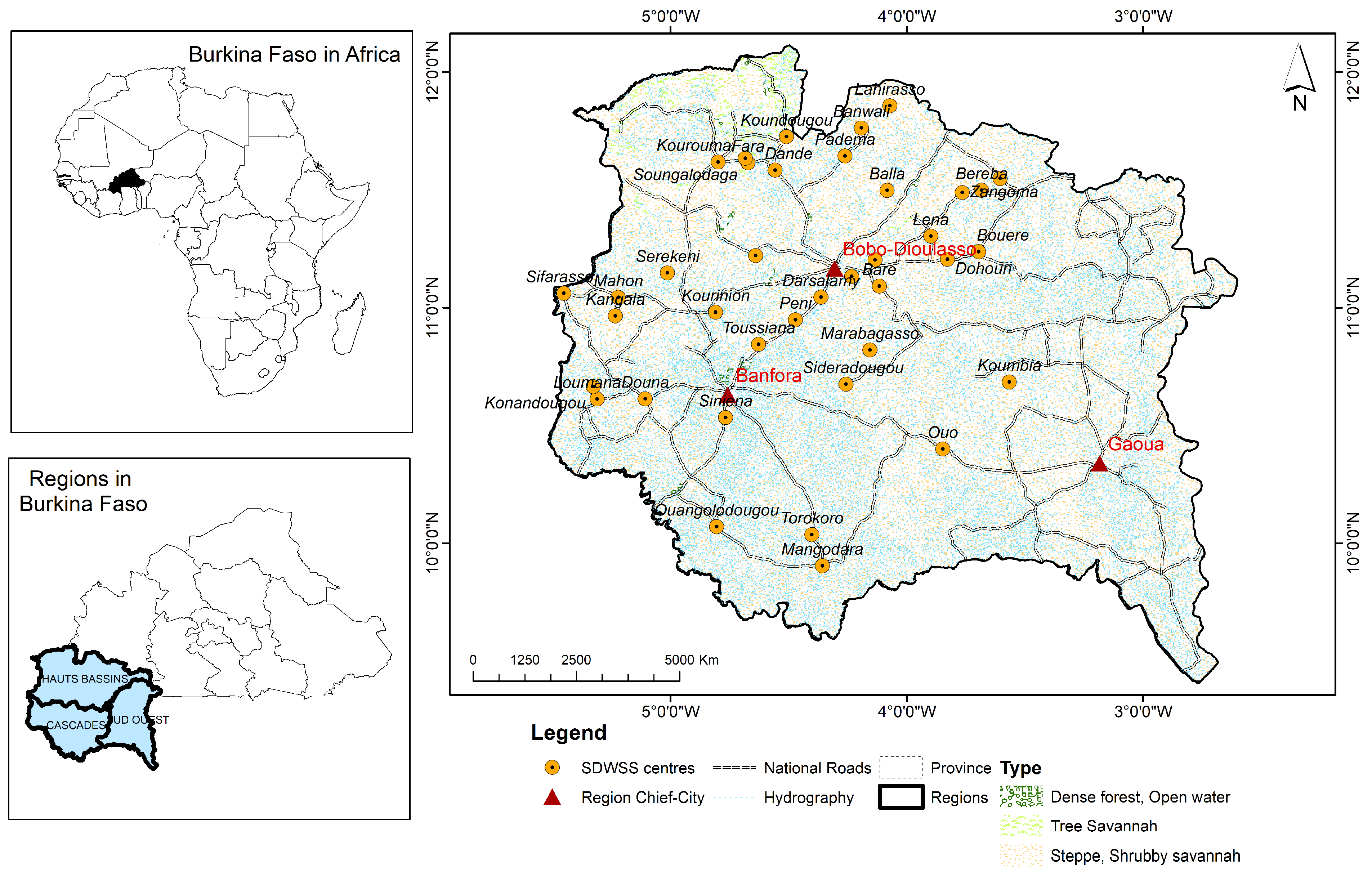
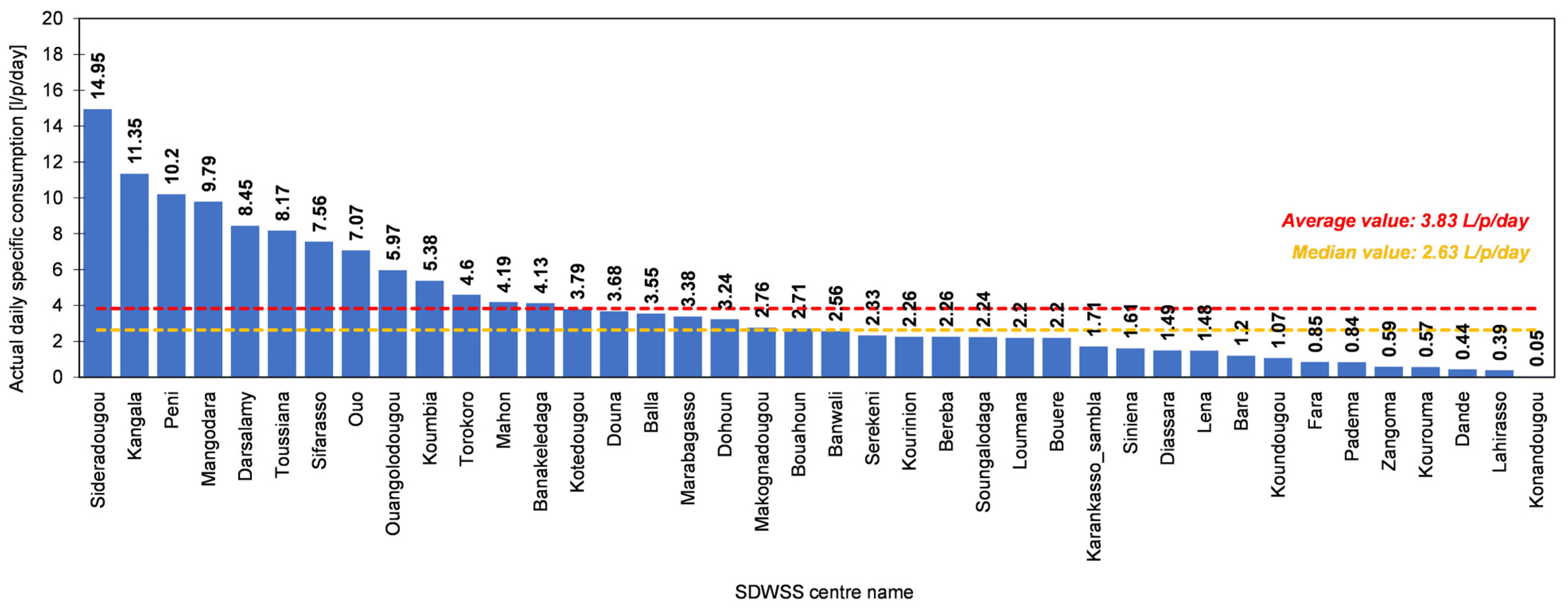
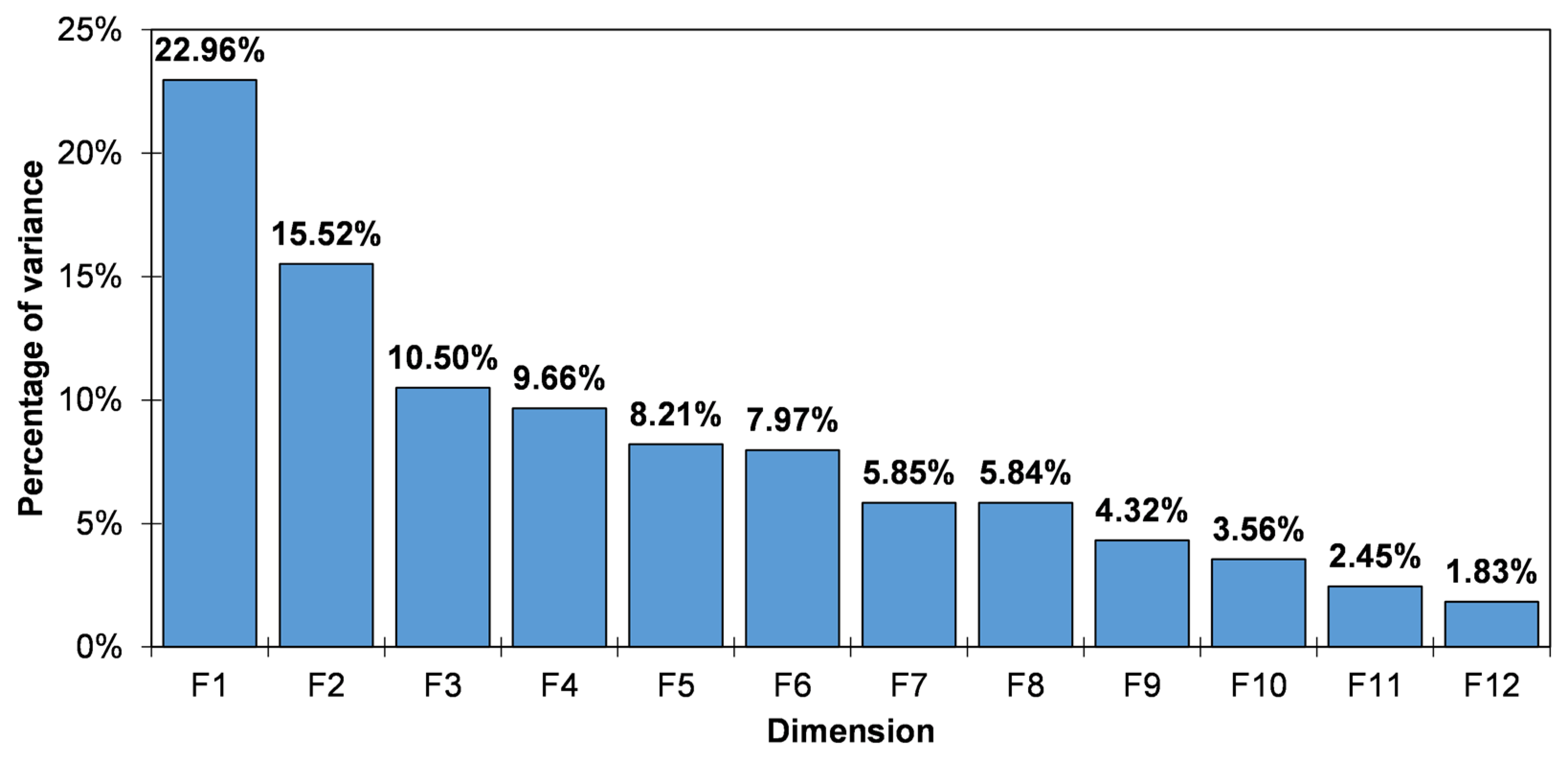

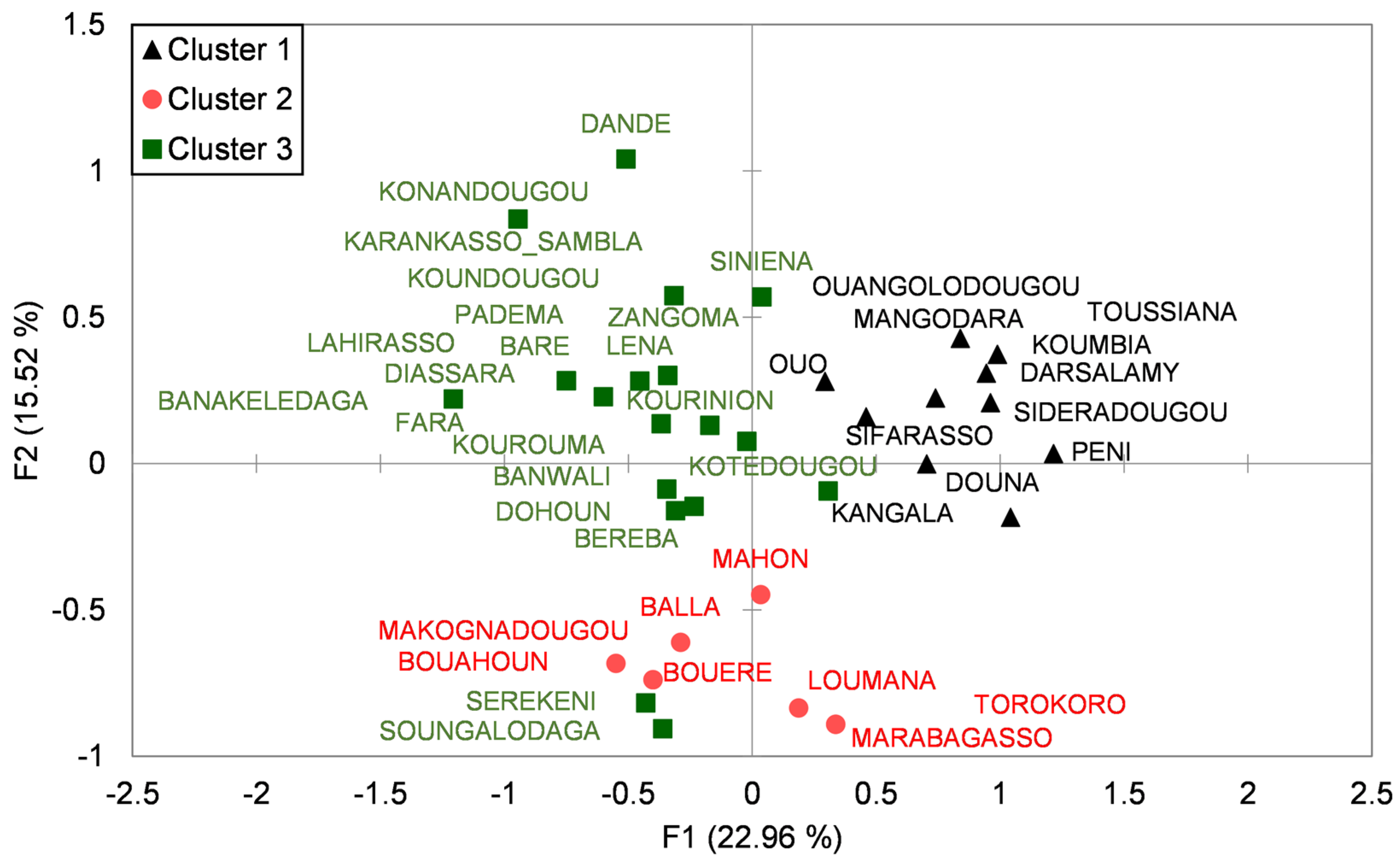
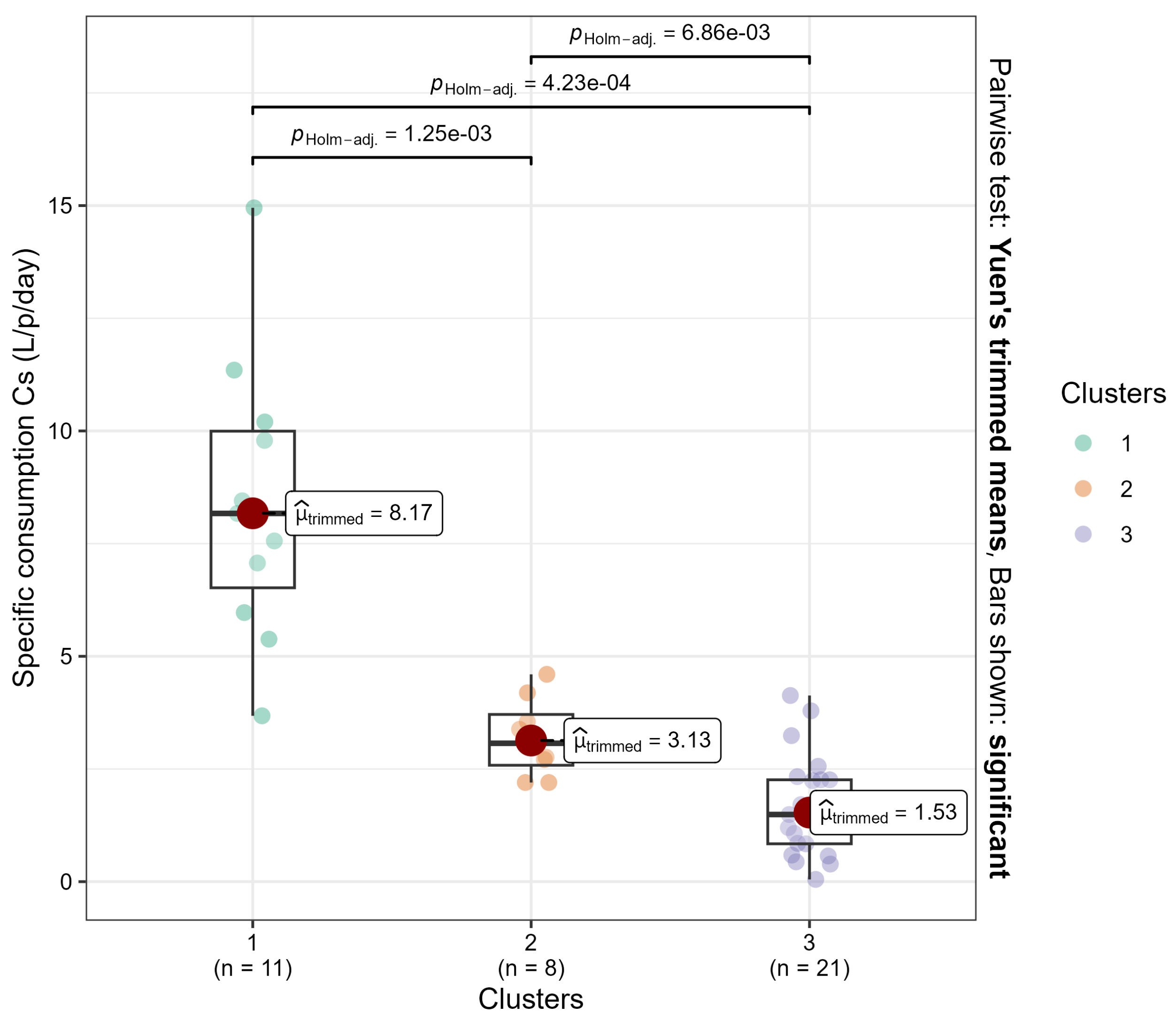

| Class Name | Description (Cs 1) | Number of SDWSS |
|---|---|---|
| Class 1 (Cs_2) | Cs < 2 L/p/day | 13 |
| Class 2 (Cs_2_5) | 2 < Cs < 5 L/p/day | 17 |
| Class 3 (Cs_5_10) | 5 < Cs < 10 L/p/day | 7 |
| Class 4 (Cs_10_15) | 10 < Cs < 15 L/p/day | 3 |
| Class 5 (Cs_15_20) | 15 < Cs < 20 L/p/day | 0 |
| Class 6 (Cs_20) | Cs > 20 L/p/day | 0 |
| Total | 40 | |
Disclaimer/Publisher’s Note: The statements, opinions and data contained in all publications are solely those of the individual author(s) and contributor(s) and not of MDPI and/or the editor(s). MDPI and/or the editor(s) disclaim responsibility for any injury to people or property resulting from any ideas, methods, instructions or products referred to in the content. |
© 2023 by the authors. Licensee MDPI, Basel, Switzerland. This article is an open access article distributed under the terms and conditions of the Creative Commons Attribution (CC BY) license (https://creativecommons.org/licenses/by/4.0/).
Share and Cite
Mounirou, L.A.; Sawadogo, B.; Yanogo, H.; Yonaba, R.; Zorom, M.; Faye, M.D.; Kafando, M.B.; Biaou, A.C.; Koïta, M.; Karambiri, H. Estimation of the Actual Specific Consumption in Drinking Water Supply Systems in Burkina Faso (West Africa): Potential Implications for Infrastructure Sizing. Water 2023, 15, 3423. https://doi.org/10.3390/w15193423
Mounirou LA, Sawadogo B, Yanogo H, Yonaba R, Zorom M, Faye MD, Kafando MB, Biaou AC, Koïta M, Karambiri H. Estimation of the Actual Specific Consumption in Drinking Water Supply Systems in Burkina Faso (West Africa): Potential Implications for Infrastructure Sizing. Water. 2023; 15(19):3423. https://doi.org/10.3390/w15193423
Chicago/Turabian StyleMounirou, Lawani Adjadi, Boukary Sawadogo, Hélène Yanogo, Roland Yonaba, Malicki Zorom, Moussa Diagne Faye, Moussa Bruno Kafando, Angelbert Chabi Biaou, Mahamadou Koïta, and Harouna Karambiri. 2023. "Estimation of the Actual Specific Consumption in Drinking Water Supply Systems in Burkina Faso (West Africa): Potential Implications for Infrastructure Sizing" Water 15, no. 19: 3423. https://doi.org/10.3390/w15193423
APA StyleMounirou, L. A., Sawadogo, B., Yanogo, H., Yonaba, R., Zorom, M., Faye, M. D., Kafando, M. B., Biaou, A. C., Koïta, M., & Karambiri, H. (2023). Estimation of the Actual Specific Consumption in Drinking Water Supply Systems in Burkina Faso (West Africa): Potential Implications for Infrastructure Sizing. Water, 15(19), 3423. https://doi.org/10.3390/w15193423








